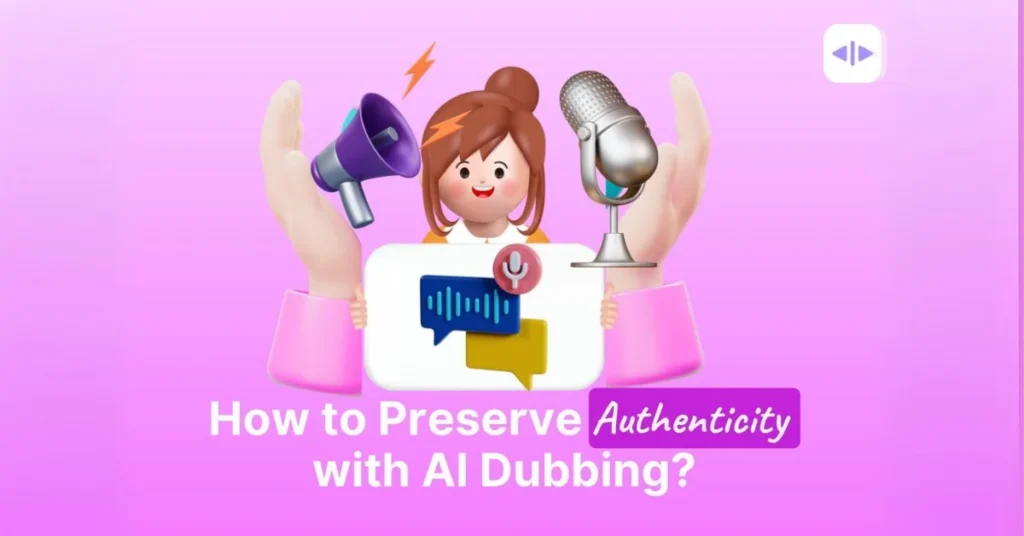In the ever-evolving landscape of video production, staying ahead of the curve requires adopting innovative technologies that streamline workflows and enhance the final product. One such technology is AI dubbing, which leverages artificial intelligence to automate the process of translating and dubbing video content. This blog will explore how to integrate AI dubbing into your video production workflow, highlighting its benefits and providing practical tips for implementation.
Understanding AI Dubbing
AI dubbing uses artificial intelligence to automatically translate and dub video content into different languages. This technology combines machine learning algorithms, speech synthesis, and natural language processing to create high-quality dubbed audio tracks that sync seamlessly with the original video. By automating this process, AI dubbing can save time, reduce costs, and make video content more accessible to a global audience.
Benefits of AI Dubbing
The benefits of integrating AI dubbing into your video production workflow are manifold. Firstly, it significantly reduces the time and effort required for manual dubbing, allowing you to produce multilingual content more efficiently. Secondly, AI dubbing can lower production costs by minimizing the need for human translators and voice actors. Additionally, AI dubbing ensures consistency in voice and tone across different languages, enhancing the viewer’s experience and maintaining the integrity of the original content. By utilizing AI dubbing free you can further streamline your production process without incurring additional costs, making high-quality multilingual content more accessible.
Preparing Your Content for AI Dubbing
Before integrating AI dubbing, it’s crucial to prepare your content appropriately. Start by ensuring that your video scripts are clear, concise, and free of jargon or idiomatic expressions that might be challenging to translate. Provide a detailed brief to the AI dubbing tool, including information about the target audience, preferred tone, and any specific pronunciation or translation preferences. This preparation will help the AI generate more accurate and contextually appropriate dubbing.
Choosing the Right AI Dubbing Tool
Selecting the right AI dubbing tool is essential for a successful integration. Consider factors such as the tool’s accuracy, language support, ease of use, and customization options. Look for tools that offer high-quality speech synthesis and natural-sounding voices. Additionally, consider the cost and whether the tool offers a free trial or flexible pricing plans. Some popular AI dubbing tools include Invideo AI, FlexClip, DeepDub, Respeecher, and Dubverse, each offering unique features to suit different production needs.
Integrating AI Dubbing into Your Workflow
Integrating AI dubbing into your video production workflow involves several steps. Start by uploading your video and script to the AI dubbing tool. The tool will then analyze the content and generate the dubbed audio tracks. Review and edit the dubbed tracks to ensure accuracy and quality. Finally, sync the dubbed audio with the original video, making any necessary adjustments to ensure a seamless match. This integration can be done in parallel with other post-production activities, streamlining the overall workflow.
Ensuring Quality and Consistency
While AI dubbing can significantly streamline the dubbing process, ensuring quality and consistency remains crucial. Regularly review and edit the AI-generated dubbed tracks to correct any errors and ensure they match the original content’s tone and context. Utilize native speakers to review the dubbed audio for linguistic accuracy and cultural appropriateness. Implementing a robust quality assurance process will help maintain high standards and ensure your multilingual content resonates with a global audience.
Enhancing Viewer Experience
AI dubbing can significantly enhance the viewer experience by making your content more accessible and engaging. Multilingual dubbed content allows you to reach a broader audience, including non-native speakers and individuals with hearing impairments. By providing high-quality dubbed audio tracks, you can ensure that viewers from different linguistic backgrounds can enjoy and understand your content. This inclusivity not only broadens your viewer base but also enhances user engagement and satisfaction.
Leveraging AI Dubbing for Marketing
AI dubbing can be a powerful tool for marketing your video content. By creating multilingual versions of your videos, you can target specific markets and demographics more effectively. Use AI dubbing to translate promotional videos, tutorials, and product demos into multiple languages, increasing your reach and engagement. Additionally, multilingual content can improve your SEO rankings by making your videos more discoverable to a global audience. This strategic use of AI dubbing can enhance your marketing efforts and drive business growth.
Overcoming Challenges in AI Dubbing
Despite its advantages, integrating AI dubbing into your workflow can present challenges. One common issue is ensuring the AI accurately captures the nuances of the original content, such as humor, sarcasm, or cultural references. Additionally, syncing the dubbed audio with the video can sometimes be challenging, requiring careful adjustments. To overcome these challenges, work closely with the AI tool’s support team, continuously refine your processes, and leverage feedback from native speakers to improve the quality of your dubbed content.
Future Trends in AI Dubbing
The future of AI dubbing looks promising, with advancements in machine learning and speech synthesis technology driving continuous improvements. Future trends may include more sophisticated AI models capable of understanding and translating complex linguistic nuances and emotions. Additionally, AI tools may offer more customization options, allowing users to fine-tune the dubbed audio to match specific preferences. Staying abreast of these trends and adopting innovative AI dubbing solutions will be crucial for maintaining a competitive edge in the video production industry.
Conclusion
Integrating AI dubbing into your video production workflow can offer numerous benefits, from reducing costs and time to enhancing viewer experience and accessibility. By choosing the right AI dubbing tool, preparing your content, and implementing a robust quality assurance process, you can effectively leverage this technology to create high-quality multilingual content. As AI dubbing technology continues to evolve, staying ahead of the curve and adopting innovative solutions will be essential for success in the competitive video production landscape.

